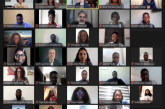By Titilayo Adewumi, Regional Sales Director: West Africa at SAP

LAGOS, Nigeria, 15 June 2021 -/African Media Agency(AMA)/- What will West Africa look like in ten years? Will we continue on the path of slow advancement, or will technology be a catalyst that could see us create a technologically advanced society such as the one embodied by Wakanda in the Black Panther movie?
Africa is arguably undergoing the most rapid and far-reaching changes of any region in the world, as a swelling population, consistent economic growth and greater digitisation of goods and services herald a new era of opportunity for progress and prosperity.
The continent’s urban population is expected to swell by an estimated 24 million people every year between 2015 and 2045, with implied increases in consumption.
By 2030, Africa’s under-18 population will grow by nearly 170 million, according to data by Unicef, and young Africans are expected to make up 42% of the world’s youth population by 2030. By the middle of the century, two in every five children under the age of 18 will live in Africa.
This demographic dividend, if given the correct mix of skills development and economic opportunity, could transform Africa’s fortunes and usher in a rapid economic development similar to that of Vietnam and China over the past twenty years.
How we collectively approach the next ten years could determine whether West Africa – and the continent as a whole – realises its potential and achieves greater prosperity for its growing population.
Africa on the move
Today, Africa accounts for 17% of the world’s population but only 3% of global GDP. This is due to change.
By 2025, household consumption in Africa could reach an estimated $2.1-trillion, and business consumption $3.5-trillion. The launch of the African Continental Free Trade Agreement has effectively started the process of creating a growing market of $1.3-trillion with a consumer base of 1.3 billion.
While the pandemic has had a devastating effect on governments, citizens and businesses across Africa, there is much cause for hope and optimism. In West Africa and elsewhere on the continent, the growing adoption of digital technologies combined with African ingenuity and innovation are contributing to a transformation of the continent’s cities, schools, businesses and governments.
Transforming learning and education
The pandemic has had a severe impact on schools and education, with many countries instituting lockdowns that kept kids out of school. The forced switch to remote work has created greater urgency within education departments across the region to fast track the process of building better e-learning capabiltiies.
The share of West African youth with post-secondary education is also rapidly increasing, from 13% in 2000 to 23% in 2020. If countries in the region can implement an accelerated education policy, we could see this share jump to 71% by 2040.
By 2030, we may well see urban and rural schools using hybrid teaching models that combine in-school and distance learning. The continued role of initiatives such as SAP Africa Code Week, which has introduced millions of kids to basic coding and digital skills since its launch in 2015, will be vital as public and private sector partners work with governments across the region to equip youth with the essential skills needed to succeed in the global digital economy.
Connectivity, digitisation creating new opportunities
Connectivity remains a challenge to improving not only the region’s e-learning capabilities, but its wider adoption of digital services. In 2015, only 15% of the population across West Africa had access to 4G technology, but this rate leapt to 63% by 2020.
The arrival of 5G in the region will accelerate connectivity and help establish entirely new ways to learn, do business, purchase products and engage with government services. This faster connectivity may also see an acceleration of telco operator efforts at diversifying. Expect to see greater innovation in payments and digital services as telcos introduce tailored new offerings to subscribers.
The switch to remote work has initiated an accelerated process of digital transformation in West African workplaces. Expect to see more mature systems and processes guiding remote and hybrid work models, with potentially new innovations from the region’s healthy startup ecosystem.
The rise of regional technology hubs that can house and incubate a new breed of African innovation-led business also point to a bright future. West Africa is already home to 142 technopoles, regional technology hubs where a new breed of innovative African businesses can start-up and grow. These include the IT & Biotechnology Village in Côte d’Ivoire, as well as incubators such as Jokkolabs which is present in several countries in the region.
The shifting consumer landscape
Greater connectivity may also unlock the region’s immense e-commerce potential. While e-commerce market growth held steady at 9% annual growth from 2010 to 2017, the region’s dominant e-commerce companies have recently made huge strides forward, including Jumia, whose growth will be accelerated following the massive $570-million funding it raised in the past six months.
However, some challenges remain before the promise of e-commerce can be fully realised across the region. Data by the Boston Consulting Group found that between 30% and 40% of products ordered over the internet are returned because the recipient cannot be found.
The region’s underdeveloped retail sector could be a blessing in disguise, as there are fewer legacy aspects to change or overcome. In 2018, there were 136 physical retail stores per million people in Latin America, 568 per million in Europe, and 930 per million in the US. In Africa, there was only 15 formal retail stores per million people.
By the end of the decade, we may also see a transformation of the in-store shopping experience, as customer experience (CX) efforts mature and greater automation and choice become available. Self-service checkout counters, contactless mobile or biometric payments, and robotic workers assisting in-store staff with certain repetitive tasks may become common sights in the region’s retail environments.
Smart homes could become commonplace, connecting households to products and services through connected appliances and home automation systems. The falling price of sensors and prospect of 5G connectivity could see entirely new categories of smart devices emerge, including clothing, consumer goods and much more.
The next ten years will be some of the most exciting and most important times in our history. As organisations in West Africa continue to invest in digital technologies and build towards becoming intelligent enterprises, new opportunities will emerge that could transform how we live, work, learn and play. I for one am excited to see how the place I call home steps into our technology-enabled future.
Distributed by African Media Agency (AMA) on behalf of SAP Africa.
Visit the SAP News Center. Follow SAP on Twitter at @SAPNews.
About SAP
SAP’s strategy is to help every business run as an intelligent enterprise. As a market leader in enterprise application software, we help companies of all sizes and in all industries run at their best: 77% of the world’s transaction revenue touches an SAP® system. Our machine learning, Internet of Things (IoT), and advanced analytics technologies help turn customers’ businesses into intelligent enterprises. SAP helps give people and organizations deep business insight and fosters collaboration that helps them stay ahead of their competition. We simplify technology for companies so they can consume our software the way they want – without disruption. Our end-to-end suite of applications and services enables business and public customers across 25 industries globally to operate profitably, adapt continuously, and make a difference. With a global network of customers, partners, employees, and thought leaders, SAP helps the world run better and improve people’s lives. For more information, visit www.sap.com.
# # #
Any statements contained in this document that are not historical facts are forward-looking statements as defined in the U.S. Private Securities Litigation Reform Act of 1995. Words such as “anticipate,” “believe,” “estimate,” “expect,” “forecast,” “intend,” “may,” “plan,” “project,” “predict,” “should” and “will” and similar expressions as they relate to SAP are intended to identify such forward-looking statements. SAP undertakes no obligation to publicly update or revise any forward-looking statements. All forward-looking statements are subject to various risks and uncertainties that could cause actual results to differ materially from expectations. The factors that could affect SAP’s future financial results are discussed more fully in SAP’s filings with the U.S. Securities and Exchange Commission (“SEC”), including SAP’s most recent Annual Report on Form 20-F filed with the SEC. Readers are cautioned not to place undue reliance on these forward-looking statements, which speak only as of their dates.
© 2020 SAP SE. All rights reserved.
SAP and other SAP products and services mentioned herein as well as their respective logos are trademarks or registered trademarks of SAP SE in Germany and other countries. Please see https://www.sap.com/copyright for additional trademark information and notices.
Note to editors:
To preview and download broadcast-standard stock footage and press photos digitally, please visit www.sap.com/photos. On this platform, you can find high resolution material for your media channels. To view video stories on diverse topics, visit www.sap-tv.com. From this site, you can embed videos into your own Web pages, share video via email links, and subscribe to RSS feeds from SAP TV.
For customers interested in learning more about SAP products:
Global Customer Center: +49 180 534-34-24
United States Only: 1 (800) 872-1SAP (1-800-872-1727)
For more information, press only:
Delia Sieff, SAP Africa, +27 (11) 235 6000, [email protected]
Adam Hunter, SAP Africa, +27 (711) 787 035, [email protected]
The post Through the looking glass: an optimist’s view of West Africa’s ten-year prospects appeared first on African Media Agency.








